Iriver Kann Cube Instruction Manual

KANN CUBE
INSTRUCTION BOOK
User Guide
CONTENTS |
Getting Started _01 |
|
|
Package Contents |
02 |
|
Product Overview |
03 |
|
Power Management |
05 |
|
Charging |
06 |
|
Connections |
07 |
|
Firmware Updates |
13 |
|
Using the Device _02 |
|
|
Basic Operations |
14 |
|
Home Screen |
18 |
|
Notification Bar |
20 |
|
Using Open APP Service |
23 |
|
AK CONNECT |
24 |
|
Listening to Music |
30 |
|
Playlist Management |
33 |
|
USB DAC Installation |
36 |
|
How to Use USB Audio |
37 |
|
CD Ripping |
38 |
|
AK CD-Player |
39 |
|
Car Mode |
40 |
|
Settings |
41 |
|
Connecting to Wi-Fi |
48 |
|
Using Bluetooth |
49 |
|
Equalizer Setup |
51 |
|
Miscellaneous _03 |
|
|
Safety Pre-Cautions |
54 |
|
Troubleshooting |
56 |
|
Copyright |
57 |
|
Certifications |
58 |
|
Registered Trademarks |
59 |
|
Disclaimers |
60 |
|
Specifications |
61 |
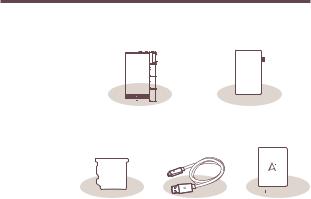
User Guide
Package
Contents
Contents may be changed without prior notice to improve the performance or quality of the product.
|
|
|
|
|
|
|
|
|
|
|
|
|
|
|
|
|
|
|
|
|
|
|
|
|
|
|
|
|
|
|
|
|
|
|
|
|
|
KANN CUBE |
Protective Film |
|||||
|
|
|
|
|
|
|
|
|
|
|
|
|
|
|
|
|
|
|
|
|
|
|
|
|
|
|
|
|
|
|
|
|
|
|
|
|
|
|
|
|
|
|
|
|
microSD Card |
USB Type-C Cable |
Quick Start Guide |
Slot Cover |
|
& Warranty Card |
Protective Film: Offers screen protection.
microSD Card Slot Cover: The cover is used to protect the microSD card slot when not in use. It is installed in the product by default.
USB Type-C Cable: For charging and data transfer. Quick Start Guide: Basic overview of device functionality.
Warranty Card: Provides warranty details for your device. Maintain a copy of this card since it may be required for future technical support requests.
User Guide: The User Guide can be downloaded from the Astell&Kern website.
[http://www.astellnkern.com Support > Download].
Getting Started 02
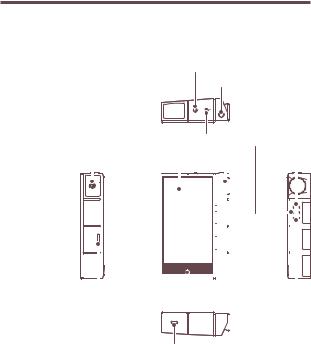
User Guide
Product
Overview
The appearance of the product, as well as the printed and engraved information, may vary depending on the model.
3.5mm Unbalanced Port / Optical Out Terminal
Power |
|
2.5mm Balanced Port Previous/Rewind |
|
XLR Out Terminal LCD Touchscreen Volume |
Play/Pause |
|
|
|
|
|
|
|
|
|
|
|
|
|
|
|
|
|
|
|
|
|
|
|
|
|
|
|
|
|
|
|
|
|
|
|
|
|
|
|
|
|
|
|
|
|
|
|
|
|
|
|
|
|
|
|
|
|
|
|
|
|
|
|
|
|
|
|
|
|
|
|
|
|
|
|
|
|
|
|
|
|
|
|
|
|
|
|
|
|
|
|
|
|
|
|
|
|
|
|
|
|
|
|
|
|
|
|
|
|
|
|
|
|
|
|
|
|
|
|
|
|
|
|
|
|
|
|
|
|
|
|
|
|
|
|
|
|
|
|
|
|
|
|
|
|
|
|
|
|
|
|
|
|
|
|
|
|
|
|
|
|
|
|
|
|
|
|
|
|
|
|
|
|
|
|
|
|
|
||
microSD Card Slot |
Home Button |
Next/Fast-Forward |
|
||||||||||||||||
|
|
|
|
|
|
|
|
|
|
|
|
|
|
|
|
|
|
|
|
|
|
|
|
|
|
|
|
|
|
|
|
|
|
|
|
|
|
|
|
|
|
|
|
|
|
|
|
|
|
|
|
|
|
|
|
|
|
|
|
|
|
|
|
|
|
|
|
|
|
|
|
|
|
|
|
|
|
|
|
USB Type-C Port
3.5mm Unbalanced Port / Optical Out Terminal:  - 3.5mm Unbalanced / S/PDIF Port symbol.
- 3.5mm Unbalanced / S/PDIF Port symbol.
For audio output, connect earphones or headphones that utilize a 3.5mm jack. Music can be played back on a S/PDIF -capable external device via an optical cable.
Getting Started 03

User Guide
Power: Power symbol.
Short press - Turns the screen on or off.
Press and hold - Turns the device on or off.
2.5mm Balanced Port: |
- 2.5mm Balanced Port symbol. |
For audio output, connect earphones or headphones that |
|
utilize a 2.5mm jack. |
|
XLR Out Terminal : For audio output, connect to a XLR-In |
|
capable external device with XLR cables. |
|
microSD Card Slot: |
microSD Card Slot symbol. |
Insert a microSD card to access its files.
LCD Touchscreen: Display screen with touch control features. Volume: Turn the wheel to adjust the playback output volume level.
Home Button: Press to return to the Home Screen. Play/Pause: Play or pause the current song.
Previous/Rewind:
Short press - Play the previous song or restart the current song.
Press and hold - Rewind the current song. Next/Fast-Forward: Short press - Play the next song.
|
Press and hold - Fast-forward the |
|
|
current song. |
|
USB Type-C Port: |
|
- DC Power symbol. |
|
||
For charging and data transfer.
Getting Started 04
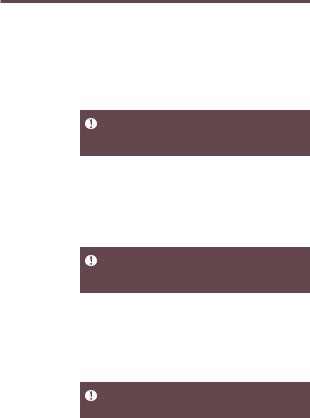
User Guide
Power Management
Powering the Device On/Off
1.Press and hold the [Power] button to turn on the device.
2.While the device is on, press and hold the [Power] button to shut down the device. A confirmation message
will appear.
3.Press [OK] to turn off the device.
This device has an automatic shutdown feature to save battery power. The device will turn off if there is no user input during the period defined in [Menu - Settings - Timer Settings - Auto Power Off] (See Page 46)
Turning the Screen On/Off
1.While the screen is on, press the [Power] button to turn off the screen.
2.Press [Power] button again to turn it on.
This device has an automatic timeout feature to save battery power. The screen will turn off if there is no user input during the period defined in [Menu - Settings - Timer Settings - Screen Timeout]. (See Page 46)
Reset Function
1.In case of unexpected device failure or freeze, press and hold [Power] for 7 seconds to force a shutdown. The device can then be restarted after the shutdown is complete.
Resetting the device will not affect stored data or time settings. Do not use the reset function while the product is in use. Doing so may corrupt the data on the device.
Getting Started 05

User Guide
Charging |
Charging via USB Wall Adapter |
|
|
|
1. Commercially available 9V 1.67A output adapters may be |
|
used for charging. |
|
|
|
Fast charging time: Approx. 4 hours (Fully discharged, Power-off, 9V |
|
1.67A adapter) / Normal charging: Approx. 5 hours 30 minutes (Fully |
|
discharged, Power-off, 5V 2A adapter) |
|
A fast charger of 9V 1.67A may be used. Using a 12V adapter will not |
|
charge the device and may cause malfunctions. |
|
The manufacturer shall not be responsible for problems caused by |
|
the use of adapters that do not adhere to the recommended |
|
specifications. |
|
|
Getting Started 06

User Guide
Connections
3.5mm Unbalanced Port
1.Connect earphones or headphones to the 3.5mm unbalanced port.
OR 

2.5mm Balanced Port
1. Connect earphones or headphones to the 2.5mm balanced port.
OR 

Connecting a to Balanced Audio Device
1.Connect to an external audio device by using the 3.5mm unbalanced port and 2.5mm balanced port.
Unbalanced Balanced Port (LR)
Port (Ground) 

Getting Started 07
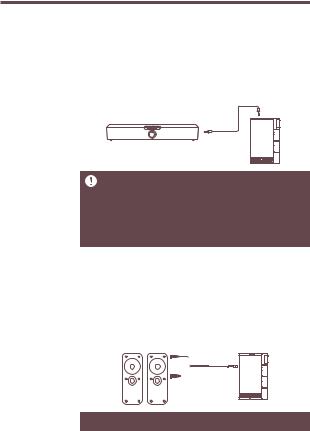
User Guide
Connecting to S/PDIF OUT
1.Using an optical cable, connect the KANN CUBE to a S/PDIF-capable external device to output music through the external device. Enable output format conversion from [Menu > Settings > S/PDIF Conversion] to convert the output to a predefined format upon S/PDIF connection.
DSD format is converted to PCM when using S/PDIF OUT.
With PCM, the output bit (16/24-bit) and sample (48/96/192 kHz) rates can be selected.
The volume will be fixed at the maximum level.
Audio may not be reproduced if the specifications of the external device and output format are incompatible. Refer to the respective instruction manual of each device before use.
Connecting to XLR OUT
1.Music can be played back on an XLR-capable external device via an XLR cable. To activate XLR audio output, enable the function in the Settings Menu [Menu > Settings > XLR]. or from the quick settings menu, active the XLR icon in the notification panel.
 XLR cable is not included in the product package.
XLR cable is not included in the product package.
Getting Started 08

User Guide
Connecting to a Computer
1.Turn on the device and your computer.
2.Use the USB Type-C cable to connect the device to a computer in accordance with settings in [Menu - Settings - USB Mode].
[Default] Media Device (USB Drive): Transfer files from a computer to the device.
DAC Input: Listen to music on a connected computer through the device. (See Page 37)
Mac users need to download and install Android File Transfer from the Astell&Kern website. [http://www.astellnkern.com > Support > Download]
For an optimal connection, quit any unnecessary programs before connecting the device to the computer.
Do not use cables other than the USB Type-C cable provided with the device. Doing so may cause malfunctions.
Use USB 2.0 only on Mac.
Type-C-to-Type-C cable is recommended when connecting with a MAC that supports Type-C port.
Getting Started 09
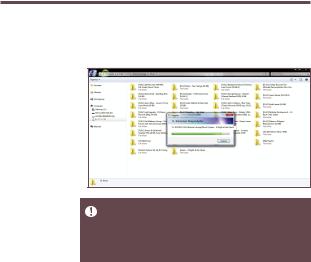
User Guide
Copy Files (Folders) to the Device
1.To copy files/folders from your computer, select the desired files/folders and drag & drop them into the device folder.
Ensure the USB Type-C cable is properly connected.
Turning off the device, computer or disconnecting the USB Type-C cable while copying or moving files/folders may corrupt files or device memory.
File transfer speeds may be affected by the computer and/or the OS environment.
Getting Started 10
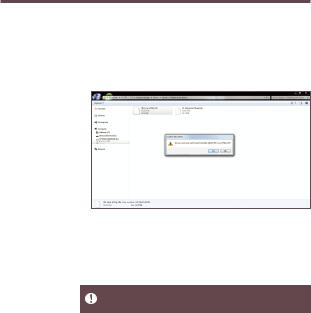
User Guide
Delete Files (or Folders) from the Device
1.Select the file/folder to delete, right-click the mouse, and then select [Delete].
2.Select [Yes] in the [Confirm File/Folder Deletion] window to delete the selected files/folders.
Disconnecting from the Computer
1.Disconnect the USB Type-C cable after the transfer between the device and computer is complete.
Disconnecting the device from the computer during a file transfer may corrupt data on the device.
Getting Started 11
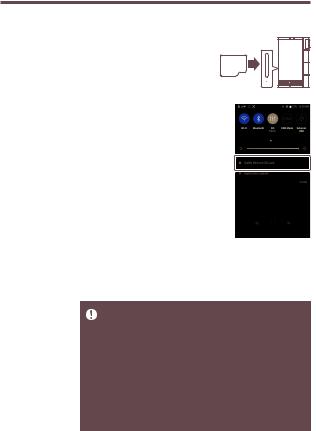
User Guide
Insert/Remove a microSD Card
1. Refer to the diagram and gently insert a microSD card into the microSD card slot.
2.To safely remove a microSD card, on the Home Screen, select [Safely remove SD card] from the Notification Bar or select [Unmount SD card] from
[Menu - Settings - System Information].
3.Gently press the microSD card in to unlock and release it from the slot.
Recommended microSD Cards
SanDisk, Transcend
Maximum Capacity: 512GB
Notes on Inserting a microSD Card
 Do not force the microSD card into the slot. Doing so may cause malfunction of the product and damage to the card.
Do not force the microSD card into the slot. Doing so may cause malfunction of the product and damage to the card.
 Do not repeatedly insert/remove the microSD card.
Do not repeatedly insert/remove the microSD card.
 If not inserted properly, the microSD card may cause product malfunctions and may become lodged in the product.
If not inserted properly, the microSD card may cause product malfunctions and may become lodged in the product.
Notes on Removing a microSD Card
 Be sure to safely remove the microSD card from the device. Not following the proper procedure may corrupt data and cause serious damage to the both the card and device.
Be sure to safely remove the microSD card from the device. Not following the proper procedure may corrupt data and cause serious damage to the both the card and device.
 Do not remove the microSD card during use. Doing so may cause malfunction, delete data and damage the microSD card.
Do not remove the microSD card during use. Doing so may cause malfunction, delete data and damage the microSD card.
Getting Started 12

User Guide
Notes on Using a microSD Card
 If the microSD card is not recognized or functions improperly, format the card, preferably in the FAT32 system.
If the microSD card is not recognized or functions improperly, format the card, preferably in the FAT32 system.
 Using cards other than the recommended microSD card types may cause malfunctions.
Using cards other than the recommended microSD card types may cause malfunctions.
 A microSD card is not included in the product package. Please purchase separately.
A microSD card is not included in the product package. Please purchase separately.
Firmware
Updates
Wi-Fi Update / OTA (Over-the-Air)
1.Connect to a wireless network.
2.If a new firmware update is available, the screen will display a Firmware Update Guide window.
3.Select [Update].
4.Follow the on-screen instructions to proceed with the firmware update.
For Wi-Fi connections, see Page 48.
The firmware update may not start if the battery level is too low. (A minimum battery level of 20% is required.)
Do not disconnect from the wireless network while downloading the update file. Doing so may cause data corruption and/or damage to the system.
If an error occurs or the notice in the Notification Bar disappears during an update, download the firmware update again through [Menu - Settings - Update - System].
Moving to another screen during a file download will cancel the download.
Getting Started 13
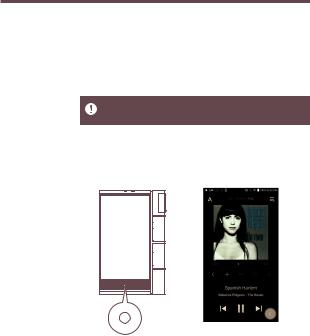
User Guide
Basic
Operations
LCD Touchscreen
1.This device features a LCD touchscreen that allows you to perform operations by touch.
Use the touchscreen to access various features on the device.
To prevent damage to the screen, do not use a sharp object or excessive force.
Return to the Home Screen
1. Press [  ] at any time to return to the Home Screen.
] at any time to return to the Home Screen.
Home Screen
Using the Device 14
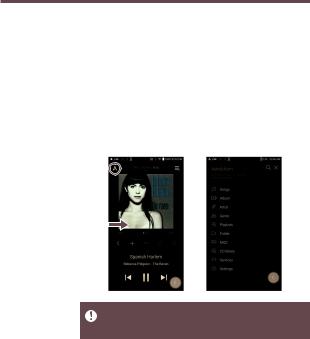
User Guide
From the Home Screen, swipe your finger to the left, right, up or down from any edge of the touchscreen to access display menus. Each side of the Home Screen will activate a different display menu.
Main Menu
1.From the left edge of the touchscreen, swipe your finger right to display the Main Menu, or tap the “A” icon in the upper left corner of the screen.
Music files extracted using the AK CD-Ripper accessory that are stored in the Ripping folder of the internal memory will be displayed in the CD library menu.
Using the Device 15
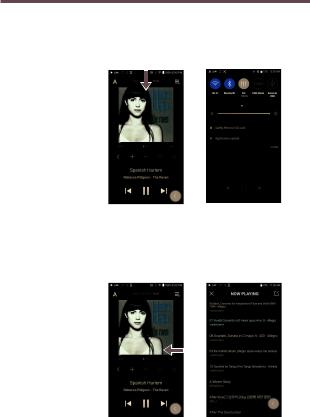
User Guide
Notification Bar
1.From the top edge of the touchscreen, swipe your finger down to display the Notification Bar.
View Current Playlist
1.From the right edge of the touchscreen, swipe your finger left to display the Now Playing menu.
Using the Device 16
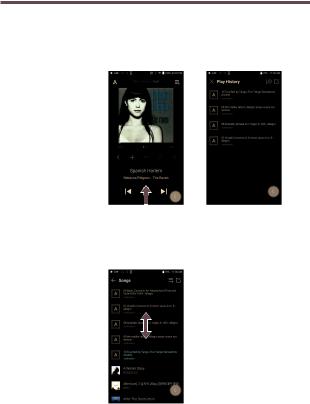
User Guide
View Play History
1.From the bottom edge of the touchscreen, swipe your finger up to display the Play History menu.
Moving Up/Down on a List
1. Scroll through a list by dragging your finger up or down.
Using the Device 17

User Guide
Home
Screen
|
1 |
|
|
|
|
|
|
|
|
|
|
|
|
|
|
|
|
|
9 |
||||
|
|
|
|
|
|
|
|||||||||||||||||
|
|
|
|
|
|
|
|
|
10 |
||||||||||||||
|
|
|
|
|
|
|
|
|
|||||||||||||||
|
|
|
|
|
|
|
|
|
|
|
|
|
|
|
|
|
|
11 |
|||||
|
|
|
|
|
|
|
|
|
|
||||||||||||||
|
2 |
|
|
|
|
|
|
|
|
12 |
|||||||||||||
|
|
|
|
|
|
|
|
|
|
|
|
|
|||||||||||
|
|
|
|
|
|
|
|
|
|
|
|
|
|
|
|
|
|
|
|
|
|
13 |
|
|
|
|
|
|
|
|
|
|
|
|
|
|
|
|
|
|
|
|
|
|
|
||
|
3 |
|
|
|
|
|
|
|
|
|
|
|
|
|
|
||||||||
|
|
|
|
|
|
|
|
|
|
|
|
|
|
|
|
|
|
|
|
|
|
14 |
|
|
|
|
|
|
|
|
|
|
|
|
|
|
|
|
|
|
|
|
|
||||
|
4 |
|
|
|
|
|
|
|
|
|
|
|
|
|
|
|
|
|
|
|
15 |
||
|
|
|
|
|
|
|
|
|
|||||||||||||||
|
5 |
|
|
|
|
|
|
|
|
|
|
|
|
|
|
|
|
|
|
|
|
|
16 |
|
|
|
|
|
|
|
|
|
|
|
|
|
|
|
|
|
|
|
|
||||
|
|
|
|
|
|
|
|
|
|
||||||||||||||
|
6 |
|
|
|
|
|
|
|
|
|
|
|
|
|
|
|
|
|
|
|
|
17 |
|
|
|
|
|
|
|
|
|
|
|
|
|
|
|
|
|
|
|
|
|
|
|||
|
7 |
|
|
|
|
|
|
|
|
|
|
|
|
|
|
|
|
|
|
|
|
18 |
|
|
|
|
|
|
|
|
|
|
|
|
|
|
|
|
|
|
|
|
|
|
|
||
|
8 |
|
|
|
|
|
|
|
|
|
|
|
|
|
|
|
|
|
|
|
|
|
19 |
|
|
|
|
|
|
|
|
|
|
|
|
|
|
|
|
|
|
|
|
|
|
||
|
|
|
|
|
|
|
|
|
|
|
|
|
|
|
|
|
|
|
|
|
|
||
|
|
|
|
|
|
|
|
|
|
|
|
|
|
|
|
|
|
|
|
||||
1 |
|
Menu |
|
Displays the Main Menu. |
|||||||||||||||||||
|
|
|
|
|
|
|
|
|
|
|
|
|
|
|
|
|
|
|
|
||||
2 |
|
Details |
|
Displays current song information. |
|||||||||||||||||||
3Song Progress Indicates song duration.
4 Recent Menu Go to the last displayed menu list.
Recent Menu Go to the last displayed menu list.
List
5 |
Add to Playlist |
Add the current song to a playlist. |
|
|
|
6 |
Title |
Song title information. |
|
|
File name is displayed when the title |
|
|
is unavailable. |
|
|
|
7 |
Artist/Album |
Displays the artist and album info. |
|
|
|
Using the Device 18
